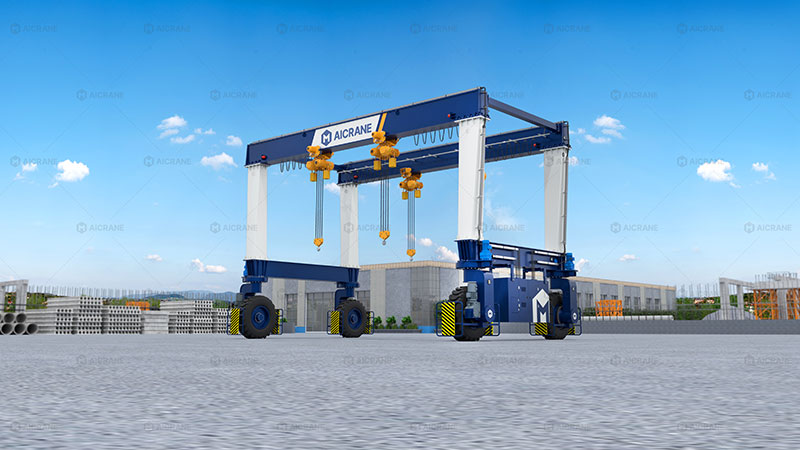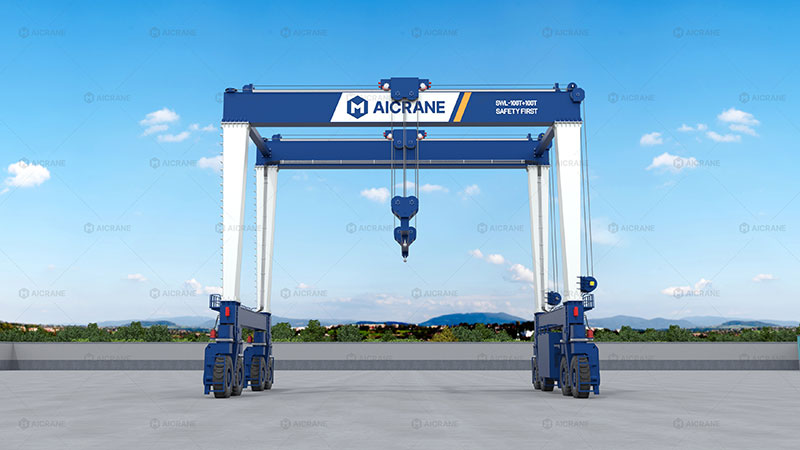Rubber Tyred Gantry (RTG) cranes are indispensable in container terminals, intermodal yards, and industrial storage facilities. Their mobility, lifting capacity, and operational efficiency make them the backbone of many port and yard operations. At the heart of an RTG crane’s performance lies its drive system – the mechanism that delivers the power necessary for movement, lifting, and load handling.
Over the years, electric, hydraulic, and hybrid drive systems have emerged as the main technological solutions. Understanding how each system works, along with their advantages and limitations, is essential for making an informed investment decision.

1. The Role of Drive Systems in RTG Gantry Cranes
The drive system of a rubber tired gantry crane is responsible for:
-
Traveling movement: Propelling the crane along the yard lanes.
-
Hoisting and lowering loads: Powering the winches and lifting mechanisms.
-
Steering and positioning: Enabling precise alignment with containers.
-
Auxiliary functions: Operating the spreader, anti-sway systems, and safety mechanisms.
The choice of drive system directly impacts:
-
Energy efficiency
-
Maintenance requirements
-
Environmental footprint
-
Operational costs
-
Responsiveness and control precision
2. Electric Drive Systems
How Electric Drive Systems Work
In an electric RTG mobile gantry crane, all major operations are powered by electric motors. Electricity is typically supplied through:
-
Diesel generator sets (traditional electric RTG)
-
Direct grid connection (via cable reel or busbar)
-
Battery energy storage systems (emerging technology)
Electric motors power:
-
Hoisting mechanisms (main and auxiliary hoists)
-
Gantry travel motors
-
Trolley travel motors
-
Steering actuators
Advantages of Electric Drive Systems
-
Energy Efficiency – Electric motors are typically more efficient than hydraulic systems, converting more energy into usable work.
-
Lower Emissions – Especially when powered by shore power or renewable energy sources, electric RTGs have minimal greenhouse gas emissions.
-
Reduced Noise – Electric motors generate significantly less noise, improving working conditions and meeting stricter environmental regulations.
-
Lower Operating Costs – Fewer moving parts mean reduced maintenance compared to hydraulic systems.
Challenges
-
Infrastructure Requirements – Cable reel or busbar systems require significant yard modification.
-
Initial Investment – Higher upfront cost compared to hydraulic systems.
-
Downtime Risk – If the power supply fails, the wheeled gantry crane is inoperable unless equipped with backup systems.
3. Hydraulic Drive Systems
How Hydraulic Drive Systems Work
Hydraulic RTG cranes use hydraulic pumps (powered by diesel engines) to pressurize fluid, which is then routed through hydraulic lines to motors and cylinders. This pressurized fluid generates motion for hoisting, trolley travel, and gantry movement.
Hydraulic drives are known for their high torque output and ability to deliver consistent power under heavy loads.

Advantages of Hydraulic Drive Systems
-
High Power Density – Hydraulic systems can deliver immense force from relatively compact components.
-
Robustness – Ideal for harsh environments and heavy-duty cycles.
-
Fine Control – Hydraulics offer smooth and precise load handling, particularly at low speeds.
-
Proven Technology – Widely used in heavy machinery, making parts and maintenance expertise more accessible.
Challenges
-
Energy Inefficiency – Hydraulic systems typically lose more energy through heat and fluid friction.
-
Higher Maintenance – Leaks, fluid contamination, and seal wear can require frequent servicing.
-
Environmental Concerns – Hydraulic oil leaks can cause significant environmental damage, leading to stricter handling requirements.
4. Hybrid Drive Systems
How Hybrid Drive Systems Work
Hybrid RTG cranes combine diesel power with energy-saving technology. There are several configurations:
-
Diesel-electric hybrid – Diesel engine drives a generator, which powers electric motors, often paired with energy storage (supercapacitors or batteries).
-
Diesel-hydraulic hybrid – Diesel engine powers hydraulic pumps, but with energy recovery systems to capture and reuse energy from load lowering.
-
Full electric-hybrid – Primarily electric drive with a small diesel generator as backup.
Advantages of Hybrid Drive Systems
-
Fuel Savings – Energy recovery systems can cut fuel consumption by 30–50%.
-
Lower Emissions – Reduces CO₂ and NOₓ emissions, helping meet IMO and port authority regulations.
-
Flexibility – Can operate in diesel mode when grid power isn’t available.
-
Reduced Engine Hours – Extends the lifespan of the primary diesel engine.
Challenges
-
System Complexity – More components mean more potential points of failure.
-
Higher Upfront Cost – Technology and energy storage systems add to the purchase price.
-
Battery or Capacitor Maintenance – Requires specialized servicing and eventual replacement.
5. Comparing Electric, Hydraulic, and Hybrid Systems
| Feature | Electric | Hydraulic | Hybrid |
|---|---|---|---|
| Energy Efficiency | High | Low to Medium | Medium to High |
| Emissions | Zero (if grid-powered) | High | Reduced |
| Maintenance | Low | High | Medium |
| Initial Cost | High | Medium | Higher |
| Operational Cost | Low | Medium to High | Low to Medium |
| Power Density | Medium | High | Medium to High |
| Environmental Impact | Very Low (electric grid) | Medium to High (oil leaks) | Low |
| Infrastructure Needs | High (grid/cable reel) | Low | Medium |
6. Choosing the Right Drive System for Your RTG Crane
When selecting an RTG drive system, key considerations include:
-
Operational Environment – Ports with established electrical infrastructure may benefit from all-electric systems, while remote yards may rely on diesel-hydraulic or hybrid systems.
-
Workload and Duty Cycle – Heavy-duty, continuous operations might favor hydraulic systems for their robustness, while intermittent operations can leverage electric or hybrid for efficiency.
-
Regulatory Compliance – Ports with strict emissions regulations may require hybrid or electric solutions.
-
Total Cost of Ownership (TCO) – Balance initial investment against long-term fuel, maintenance, and environmental costs.
-
Future Scalability – Consider whether the gantry crane can be upgraded to a more eco-friendly drive in the future.
7. Future Trends in RTG Drive Systems
-
Full Electrification – Driven by port decarbonization goals and falling battery prices.
-
Regenerative Energy Recovery – Capturing energy from lowering loads to further reduce consumption.
-
Smart Power Management – AI-based systems that optimize power usage based on workload.
-
Hydrogen Fuel Cell RTGs – Early pilot projects are exploring hydrogen as a clean alternative to diesel.
-
Modular Upgrades – Drive systems designed for easy replacement or hybrid conversion.
Conclusion
The choice between electric, hydraulic, and hybrid drive systems for RTG gantry cranes is more than just a technical decision – it’s a strategic investment in operational efficiency, environmental responsibility, and long-term cost savings.
-
Electric systems lead in efficiency and sustainability.
-
Hydraulic systems offer durability and raw power for demanding applications.
-
Hybrid systems strike a balance, offering fuel savings and flexibility.
As technology advances and ports push towards greener operations, the future will likely see a shift towards fully electric or advanced hybrid RTG cranes equipped with regenerative and AI-driven power management systems. For now, the best choice depends on your site’s infrastructure, operational demands, and sustainability goals.
